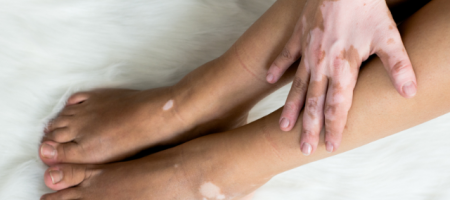Vitiligo

Vitiligo is a human skin condition that turns patches of skin and hair white and affects approximately 1% of the population.
Vitiligo is not painful and does not have significant health consequences; however, it can have emotional and psychological effects.
Symptoms
Vitiligo signs include:
- Patchy loss of skin colour, which usually first appears on the hands, face, and areas around body openings and the genitals
- Premature whitening or greying of the hair on your scalp, eyelashes, eyebrows or beard
- Loss of colour in the tissues that line the inside of the mouth and nose (mucous membranes).
Vitiligo can start at any age, but usually appears before age 30.
Depending on the type of vitiligo you have, it may affect:
- Nearly all skin surfaces. With this type, called universal vitiligo, the discoloration affects nearly all skin surfaces.
- Many parts of the body. With this most common type, called generalised vitiligo, the discoloured patches often progress similarly on corresponding body parts (symmetrically).
- Only one side or part of the body. This type, called segmental vitiligo, tends to occur at a younger age, progress for a year or two, then stop.
- One or only a few areas of the body. This type is called localised (focal) vitiligo.
- The face and hands. With this type, called acrofacial vitiligo, the affected skin is on the face and hands, and around body openings, such as the eyes, nose and ears.
It’s difficult to predict how this disease will progress. Sometimes the patches stop forming without treatment. In other cases, pigment loss spreads and eventually involves most of the skin. Occasionally, the skin gets its colour back.
Causes
Vitiligo is thought to be an autoimmune condition that affects males and females of all ages and races. The immune system fights infection, but in vitiligo, it attacks the skin’s pigment cells (melanocytes).
The destruction of the pigment cells results in white spots on the skin and sometimes also the mucosa (lips and genitals) and hair, eyelashes and eyebrows.
It is not an infection, contagious, cancerous or caused by food. It is generally not passed down to children; affected individuals are usually otherwise fit and healthy.
Unfortunately, there is no way to determine if a person’s vitiligo will progress over time. The condition undoubtedly carries a significant psychological burden for many, which may impact work, life and relationships. Education and increasing public awareness of vitiligo is the sure way to remedy this problem.
Vitiligo is best diagnosed by a dermatologist. The skin assessment in the consulting rooms is all that is required, but occasionally, a skin biopsy is needed to confirm the diagnosis.
While there is no blood test to diagnose vitiligo, blood tests may be ordered to assess for other autoimmune conditions.
Treatments
Although not all patients with vitiligo may opt for or require treatment, various options are available.
The treatment objectives are twofold: to prevent further progression of vitiligo and to stimulate re pigmentation of the white skin patches. However, even if the treatment is successful in restoring skin colour, it may only result in partial, rather than complete, recovery.
Non-cultured Epidermal Cellular Grafting which is a technique that involves taking a thin piece of skin from a hidden area such as the thigh, placing the skin into a test tube or dish and adding a chemical (trypsin) to separate all of the skin cells. A laser is used to remove the top layer of skin from the white area of vitiligo and the liquid suspension of cells is placed onto this site. The patient’s own skin cells then grow into the area and start to re-pigment the skin. As only the top layer of skin has been removed, it heals without scarring. Since the technique involves the patient’s cells, the colour matches the patient’s skin colour and should tan normally.
Steroids creams (cortisone) and non-steroid (e.g., tacrolimus) creams work by dampening down the immune system; i.e., they reduce inflammation. Remember it is an ‘overactive’ part of the immune system that is causing vitiligo.
Ultraviolet therapy is an essential component of vitiligo treatment, even though the depigmented skin patches are more vulnerable to sunburn compared to healthy skin. Most dermatologists provide an artificial form of UV, in ‘light boxes’ which are specially designed to treat skin conditions, including psoriasis and eczema. In the past a form of light therapy called PUVA was used, which also involved taking a capsule before standing in the light box. These days most medical light boxes use so-called ‘narrowband UVB’, which is both safer and more effective than older machines (and different from the UVA light emitted from solarium machines).
UV therapy (including natural sunlight) has the effect of dampening down the immune system in the skin. It may also have the effect of ‘stimulating’ melanocytes to re-pigment the skin.
Other treatment may include:
- Immune-suppressive therapy
- Excimer lamp therapy
- De-pigmentation (skin bleaching)
Resources
For further information, you can visit the following resources:

